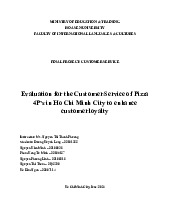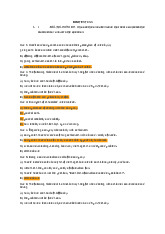



















Preview text:
lOMoAR cPSD| 47206071 I - Executive summary
This business report aims to evaluate the quality of customer service provided by
Shopee Vietnam. The report focuses on three key criteria: timing, user-friendly
website, and responsiveness to customer feedback.
In addition, this report analyzes survey data on customer service quality at Shopee
Vietnam. Using a quantitative survey method, the team collected general
information from customers aged 18-34 and their frequency of using the Shopee platform for shopping.
The findings and discussions of this report will highlight the effectiveness of
Shopee Vietnam's customer service based on the aforementioned criteria and
provide insights into areas for improvement. II - Table of content
III - Introduction
1.1. Background
Shopee E-commerce has risen as a leading player in online buying and selling in
Vietnam for consumers to find products on the market either to buy or for selling
at. Shopee was established in 2015 by Sea Group, to become one of the most top
e-commerce platforms in the region with fun, smooth, and dependable shopping
experience based on the Vietnamese market. Thanks to the platform's swift growth
and widespread use throughout Vietnam, businesses must put much attention to
the customer service approach.
One of the reasons for Shopee Vietnam’s big presence in the e-commerce
landscape, besides being user friendly and accessible, is that it can compete well
with traditional hypermarkets. Vietnam offers thousands of categories that
shoppers can browse from and choose from such as fashion, electronics, home
goods, and groceries. Shopee’s unique strategic focus on mobile commerce,
mirrors the lifestyle of mobile first Vietnamese millennials and Gen Z consumers.
As a localized solution, Shopee has successfully captured Vietnamese hearts with
millions of users that just don’t stop selling through the platform — a community of constant users.
The purpose of this business report is to evaluate the quality of Shopee Vietnam’s
customer service. As technology and customer service evolve, it becomes ever lOMoAR cPSD| 47206071
more crucial for companies such as Shopee Vietnam to provide to their audience
the level of service they expect. This report will delve into the various facets of
Shopee Vietnam's customer service model, focusing on three critical areas: It is
the use of friendly websites and electronic communications, exceeding customer's
expectations in terms of convenience and timing, and relentlessly listening to customers' feedback.
1.2. Objectives of the report
In order to evaluate whether Shopee, being one of the biggest e-commerce
platforms in Vietnam, serves the customers in a good way, this business report is
created. The assessment will be based on feedback and experiences from survey
participants regarding the quality of Shopee's customer service, focusing on three
key criteria: user friendly website, timing, and responsiveness to customer feedback.
This report was motivated by the requirement to understand how these customer
service practices impact on user satisfaction and retention. If you are in the
competitive e-commerce market, you need to offer great customer service as a
way to keep customers returning and to maintain their trust. The aim of this work
is to bring a high degree of clarity into those areas where Shopee does meet
customer expectations and, to that extent, lays the foundation for customer
satisfaction and loyalty in those areas.
Furthermore, this report seeks to determine any limitations in the surveying
process, for example sample size, respondent bias, or variation from accuracy of
response. By acknowledging these possible limits, our discussion of and
adjustments to our methodology will be more productive insofar as our findings are
the most accurate and representative.
1.3. Scope of the report
The purpose of this report is to investigate the customer service of Shopee Vietnam
through a group of diverse respondents 18–45 years old. The respondents fall into
three age ranges: Under 18, 18 - 24, 25 - 34 with special focus on under 34. lOMoAR cPSD| 47206071 IV - Literature Review
My team used three aspects in the book Career Success Through Customer
Loyalty by author Paul R. Timm. Here is a summary of the theory that we have learned.
To begin with, the first factor- Listen to Your Customer, Timm (2014) mentioned
that the difference between “hearing” and “listening” gives businesses an insight
when applying to Customer Service. From there, Timm dived into the details by
listing the factors that interfere with the listening process and potential barriers
worth noting including factors within the listener’s mind, environmental factors
surrounding the communication process, and interaction factors that arise mainly
from the listener’s selfishness and self-protection. That has led to
misunderstandings in communication due to the amount of information from the
sender being transmitted to the receiver being too much, or maybe it is because
businesses have not fully utilized their listening ability. Although issues of
selfishness and self-preservation are factors that complicate the listening process,
these factors are necessary conditions for interaction in the listening process. From
the above complex discussions and research, the author has found ways to
become a better listener. Avoid poor listening behaviors such as pretending to pay
attention, changing channels, listening only for facts, responses that turn people
off, impatience, and overusing gatekeepersgatekeepers play a significant role in
filtering and prioritizing what needs the manager’s attention. Notwithstanding,
misuse of gatekeeping can create communication barriers, distort information, or
prevent critical messages from being heard. In addition to avoiding the above
behaviors, asking for clarification, skillfully using counter-support, and minimizing
the number of moderators improve listening effectiveness according to Timm (2014).
The next factor mentioned in the author's coursebook is “Use Friendly Websites
and Electronic Communication”. There is an undeniable fact that the internet is a
potentially powerful avenue to provide customer support Timm (2014) stated. In
this day and age, companies are failing to maximize their service potential and
email is a prime example. The author mentioned a general rule for customer
service that all customer emails should be acknowledged and responded to within
two hours or less. What is more, web chat is considered the benchmark of Internet
chat technology adaptation, which allows customers and service representatives
to have two-way communication. Blogs and social media sites are designed to
serve these functions. Next, Timm analyzed and evaluated websites, providing lOMoAR cPSD| 47206071
continuous data that will improve the performance of the business website.
Moreover, web self-service has a huge advantage in terms of outlay compared to
traditional customer service channels. Furthermore, Eservices are not only more
cost-effective but can also bring additional benefits for instance reinforcing
customer relationships. Having said that, there are still a handful of customers who
prioritize the “human touch” of the real person, and having poor e-services
management stems from disabling any potential savings and leading to customer
loss. Hence, Timm (2014) pointed out that providing an effective e-service requires
organizations to pay attention to several factors such as ease of website
navigation, server speed as well as website uptime must be ensured in the most
stable way. Moreover, personal touch and user-friendly websites will avoid
customer turn-off. Benchmarking, adaptive knowledge base, traffic tracking,
proactive communication changes, and customer loyalty programs are
indispensable elements when a company builds a successful eservice, Timm said.
Last but not least, according to Timm (2014), exceeding expectations with regard
to convenience and timing will be a necessary factor when implementing eservices
to complete a business's customer service process. To provide customer service
that exceeds expectations with regard to timing and convenience, businesses must
thereby enhance customer loyalty. It is an inevitable fact that waiting is a source of
frustration for customers and can be reduced by reducing actual waiting time. For
example, some companies have set time expectations that they know they can
meet, even though the delivery time is 9 am they will always deliver the order 10-
15 minutes earlier than expected to minimize the actual waiting time of the
customer as well as exceed the customer's expectations. In addition, queuing
systems are crucial for a business, what is more, to reduce actual waiting time,
companies can also distract customers by providing entertainment options or
virtual waiting services such as store pages. According to Timm (2014), to
maximize operational performance, we need to provide simple products integrated
with other additional services to maximize customer convenience. In this
contemporary day, the popularity of online shopping has supported companies to
imagine a panorama and clear picture of their convenience and time situation by
utilizing Mystery Shopper and Explorer to refer to what other organizations are
doing. In short, according to the author, convenience will drive many benefits to a
business. Having said that convenience does not always mean “quick service”.
Some services such as skin care consultation or fine dining need to be intentionally
slow because no customer is satisfied when spending a large amount of money to
receive a “quick service”. To summarise, we need to evaluate the service we lOMoAR cPSD| 47206071
provide to customers accurately so that we can find a solution to maximize time
convenience to exceed customer expectations, Timm said.
Through the literature review compiled from the arguments of Timm (2014), our
group will have a more general view and based on that, evaluate Shopee's online
shopping and delivery services. lOMoAR cPSD| 47206071 V - Methods
1. Data collection
The survey questionnaire is carefully researched and the questions mainly focus
on the issues of customer service quality of the Shopee app and are conducted
on the Google form platform. There are a total of 5 sections including the
following. Part 1 asks the surveyor's demographics and their usage of the app.
Next is the online customer service section consisting of 7 questions with
research content on the frequency of handling customer inquiries. The next
sections of the survey cover a variety of emotional and practical questions that
customers have experienced while using the app. We have carefully
conceptualized each question to ensure that the above questions give us the
most concrete and realistic results. It took us more than two weeks to conduct
this survey with many different subjects. We aimed to find 100 participants
ranging in age from 18 to 45 years old.
We mostly used scale questions to create the questionnaires. Additionally, net
promoter scores (NPS) are applied in questions 15 and 16. On a scale from 1-10,
we derive the results of the desire of customers and the fact that customers will
continue to recommend the application to their relatives. 2. Data analysis:
The information and results that we obtained after this questionnaire are based
on various forms such as pie charts and scales. Not only that, with the questions
we always provide many options for participants to make it easier for them to
take this survey. Next, the results were returned to the Google Form statistics
table. Additionally, we received extremely useful results and brought more
comments for us to continue analyzing in the discussion section.
VI - Findings & discussions 1. Findings:
We obtained the following practical results based on the 20 active survey questions over 2 weeks. lOMoAR cPSD| 47206071
Figure 1: The age group of participants
At first, we aimed to find just 100 participants; however, after 2 weeks, we
received 115 responses ranging mostly from 18 to 24 years old (figure 1).
Additionally, there is a small percentage of participants ranging under 18 and from 25 to 34 years old.
Figure 2: The shopping frequency of participants on Shopee e-commerce
From figure 2, we can see that our participants have used Shopee. 44,3% of
them used Shopee monthly, 27,8% weekly. Additionally, 11,3% of respondents used Shopee daily.
As a result, overall, our sample is people who range from 18 to 34 and have used Shopee e-commerce. lOMoAR cPSD| 47206071
Figure 3: The percentage of the easiness when using FAQs on Shopee ecommerce
Figure 4: Shopee’s response time on Email, Issue requests
With figure 3, we can see that over 40% of participants pointed out that it was
easy to find answers to their questions on Shopee. Similarly, figure 4 also shows
a percentage almost similar to figure 1 with 47.7% of users saying that within 24 lOMoAR cPSD| 47206071
hours, they received Shopee's response email. This figure not only shows the
service quality of the application but also reflects the popularity of the online
shopping community application.
Figure 5: The percentage of the general quality of Shopee’s customer service
Figure 6: The number of participants in Shopee’s live chat/ web chat
In terms of, the quality of Shopee's customer service is shown through figure 5
and figure 6. With figure 5, nearly 60% of survey participants felt completely
satisfied with the quality of customer service provided by Shopee. In addition, lOMoAR cPSD| 47206071
figure 6 in this survey also has 63.1% of consumers who have had experience
with chatting or texting with the switchboard of this application for support
inquiries. However, the result of figure 6 only gives the number of people who
have experienced it. In general, the final results of these two questions were
relatively positive, proving that Shopee was able to satisfy a large number of people.
Figure 7: Shopee’s Delivery Time
Figure 8: Shopee’s customer expectations for delivery
In addition, when talking about Timing, it can be seen that the two charts above (
Figure 7 & Figure 8) have a correlation point. Figure 7 shows the objective lOMoAR cPSD| 47206071
reality of customers about Shopee's delivery time with them. Besides that, figure
8 presents the customer's feelings about the level of delivery expectations. The
rate of 60.4% "satisfaction" in figure 8 may correspond to 60.4% "regular" in
figure 7, indicating a close relationship in the matter of satisfied customers
because Shopee regularly meets their delivery expectations.
Figure 9: The areas of Shopee needs to improve
Not only that, when surveying the points that should be overcome that users want
Shopee to improve, it has been obtained with 60 people corresponding to 54.1%
of the opinion that they want the time to respond to inquiries to be overcome
quickly for convenience in the process of using the application. Accordingly, there
are two other opinions that the quality of support and knowledge base also need
to be taken care of to develop the quality of Shopee's services. 2. Discussions:
This discussion will evaluate the quality of Shopee's customer service, specifically
focusing on three aspects: how they use friendly websites and electronic
communication, exceed customer expectations by improving convenience and
timing, and listen to their customers.
2.1. Use Friendly Websites and Electronic Communication
According to Timm (2014), there are some ways on Web-based customer service
that customers can use to contact businesses for support. The author points out lOMoAR cPSD| 47206071
that there are four ways on websites that can provide some kinds of customer
service that businesses must consider: Self-serve Common Answers, Delayed
Answers, Live Answers and Self-serve Personalized Answers. However, we will
focus on Self-serve Common Answers, Delayed Answers and Live Answers. a.
Self-serve Common Answers
Timm (2014) claimed that customers can answer their own questions by using
knowledge bases, which are databases of answers to frequently asked questions (FAQs).
Figure 10: The number of participants in Shopee’s FAQs sessions lOMoAR cPSD| 47206071
Figure 11: The effectiveness of Shopee's FAQs sessions
Through the survey, we found the knowledge base a.k.a FAQs is widely used,
indicating it is a valuable resource. Figure 10 and 11 demonstrated the results of
overall customer satisfaction with the effectiveness of Shopee's FAQs. Over half
of the respondents found the FAQs compelling, However, the 41.1% neutral
responses suggest that while the information might answer basic questions, it
might not always provide comprehensive or detailed guidance for more complex
issues. Additionally, 7.5% of users found it ineffective, pointing to possible gaps in
information or unclear instructions. To improve, Shopee could expand the depth of
its knowledge base, include more troubleshooting scenarios, and incorporate
multimedia content like step-by-step videos or screenshots to enhance clarity and usability. b. Delayed Answers
According to Timm (2014), customers frequently use email or texting when
selfserve websites are unable to provide the information they require.
The provided chart below illustrates that Shopee’s response time is efficient for
most users. With 90.4% of users receiving a response within 24 hours. Specifically,
21.7% get a response within 1 hour, and 20.9% within 2 hours, which demonstrates
a commendable commitment to timely service (Figure 10). However, 9.6% of users
experience delays longer than 24 hours. While this number is small, it can still lead
to frustration for customers with urgent issues. Shopee could aim to minimize these
delays by expanding customer support resources, optimizing workflow automation,
or providing estimated response times to manage customer expectations. lOMoAR cPSD| 47206071
Figure 12: Shopee’s response time on Email, Issue requests c. Live Answers
According to the author, web chat and live chat, which are more expensive but
frequently appreciated additions to the customer service options, can offer
highassistance service. Businesses implemented online chat in response to
consumer complaints regarding the slow response times of email inquiries. When
a customer needs help, the customer service agent can speak with them live (in
"real time") through live chat. Both parties type their questions and answers in all
text-based communications. The customer can frequently review the entire
transcript of the chat session.
When it comes to Shopee, Figure 13 below shows that a majority of 62.6% of
respondents have used Shopee’s live support services, including chat, messaging,
or the hotline. This indicates that many users prefer direct, real-time interaction to
resolve issues. However, the 37.4% who haven’t used these services might be
unaware of them, prefer self-service options, or find these channels inconvenient.
Shopee could increase awareness by prominently displaying these options and
ensuring they are easy to access. Additionally, offering 24/7 support and improving
response quality could encourage more users to leverage these services. lOMoAR cPSD| 47206071
Figure 13: The number of participants in Shopee’s live chat/ web chat
Furthermore, according to figure 12, only 40% of users rated their experience with
live support positively, while 48.6% remain neutral. This significant neutral
percentage suggests that while support resolves issues, it may not provide an
outstanding or memorable experience. The 11.4% negative feedback (Poor and
Very Poor) indicates that some users are dissatisfied, possibly due to slow
responses, lack of knowledge, or ineffective problem resolution. To improve,
Shopee could invest in training support staff, enhancing communication skills, and
ensuring that support agents are equipped to handle complex issues effectively. lOMoAR cPSD| 47206071
Figure 14: The effectiveness of Shopee’s live chat/ web chat
2.2. Exceed Expectations with Convenience and Timing
According to the author, customer convenience is derived from the quickness of
service and ease of conducting business. Organizations can exceed customer
expectations and provide A-plus ease and speed by implementing or altering
actions that convey to customers that the company appreciates their time and
wants to conduct business in a timely manner that makes their lives easier. People
tend to like businesses that offer quick service because they value time more than
ever before nowadays. Therefore, waiting is an unavoidable cause of frustration
for customers, which can be decreased by shortening the actual waiting time. For
Shopee, they meet the time expectation of the customers, which can create
customers convenience and gain their loyalty. a. Convenience
The results from figure 15 clearly shows that a majority of respondents
(approximately 70.5%) find Shopee either "More convenient" or "Very convenient"
when compared to competitors. This indicates that Shopee is performing
exceptionally well in terms of user convenience, a critical factor in online shopping
satisfaction. Meanwhile, only a minority, 8.7%, consider Shopee less convenient.
This suggests that Shopee has effectively optimized its platform's user experience,
likely through intuitive navigation, variety of payment methods, and strong logistical
integration. However, the 19.1% who feel the convenience is "Similar" indicate that
there is still competition within the ecommerce space. Shopee should continually
enhance unique features to stand out further in customer convenience. lOMoAR cPSD| 47206071
Figure 15: Convenience of shopping on Shopee compared to other
ecommerce platforms b. Timing
Figure 16: Shopee’s Delivery Time
From figure 16, it is clear that 74.8% of respondents (combining "Satisfied" and
"Very satisfied") are content with Shopee's delivery time. This is a positive sign,
indicating that Shopee has maintained an effective and reliable delivery process.
Customer satisfaction with delivery is a major factor in e-commerce success, as it
directly impacts trust and retention. However, 21.7% of respondents remain
neutral, suggesting that Shopee's delivery speed may not stand out significantly lOMoAR cPSD| 47206071
from its competitors. Additionally, while a small fraction (3.5%) expressed
dissatisfaction, this indicates room for improvement in specific delivery-related
issues, such as delays, tracking accuracy, or delivery coverage. While the majority
are satisfied with delivery times, consistency remains key. Shopee should work to
reduce occasional delays and ensure more customers have consistently positive delivery experiences c.
Meeting Customer Expectations for Delivery
Figure 17: Shopee’s customer expectations for delivery
Survey results reveal that while 75.7% of respondents indicated that Shopee
"Always" or "Frequently" meets their delivery expectations, there is still a notable
21.7% who feel it is only "Occasionally". This suggests some inconsistency in
Shopee's delivery services, which could stem from factors like location-specific
delays, courier performance, or external challenges like weather or holidays. The
15.7% who feel Shopee "Always" meets expectations represents a strong base of
highly satisfied customers. Nevertheless, to further improve performance, Shopee
should improve logistics, partnerships with reliable couriers, and better
communication regarding delivery timelines can help Shopee close this gap. lOMoAR cPSD| 47206071
2.3. Listening to customers:
Figure 18: The percentage of Shopee’s levels on listening to customers
Figure 19: The percentage of Shopee’s levels on resolving satisfactorily the
complaints or issues of customers
Through figure 18, we examined participants' perceptions of how well Shopee
listens to customer feedback. Out of 115 respondents, 36.5% feel that their
concerns are always acknowledged, while 46.1% believe they are often heard.
However, a notable 14.8% indicated that their feedback is only sometimes taken
into account, with no respondents reporting that their concerns are rarely or
never acknowledged. This data suggests that Shopee has a strong foundation in lOMoAR cPSD| 47206071
customer engagement, but there is still space for improvement to ensure that all
customers feel consistently heard.
Additionally, according to figure 19, this chart delves into how often participants
feel their complaints are resolved satisfactorily. Among 115 respondents, 15.7%
stated that their issues are always resolved, and 37.4% indicated that they are
often addressed. Nevertheless, a combined 38.3% felt that their complaints are
only sometimes resolved satisfactorily, with 7.0% believing they are rarely
addressed and 1.7% feeling their concerns are never resolved. While the data
reflects a solid foundation for complaint resolution, the significant percentage of
respondents who experience only occasional or no resolution highlights the need
for improvement in the resolving problems area of Shopee.
Together, through figure 18 and figure 19 Shopee generally listens to customers
well, as a majority of respondents feel that their feedback is acknowledged.
However, there are still areas to improve, especially in resolving complaints, as
some customers are not happy with how their issues are handled. By working on
these problems, Shopee could make customer experiences even better.



